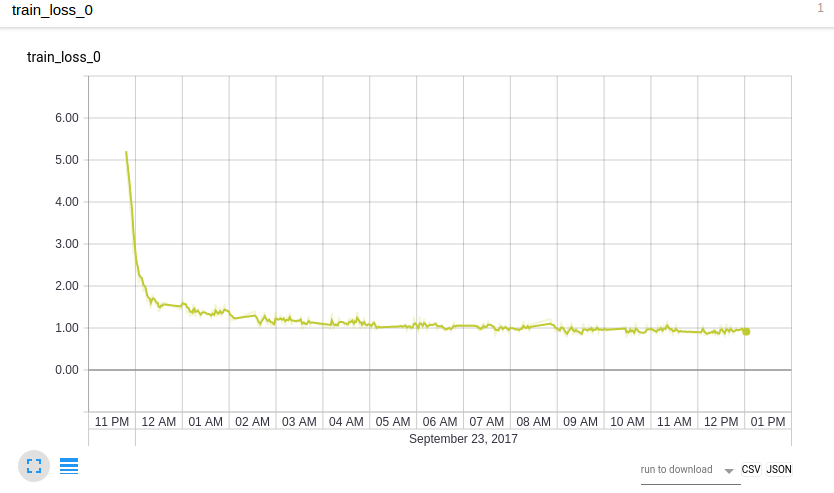This projetc is based on gujiuxiang's chinese_im2text.pytorch. But there are some bugs in his repository, this project tries to fix them. His project is based on ruotian's neuraltalk2.pytorch. Most of codes are from that amazing projects
Python 2.7 (because there is no coco-caption version for python 3), PyTorch 0.2 (along with torchvision).
You need to download pretrained resnet model for both training and evaluation, and you need to register the ai challenger, and then download the training and validation dataset.
TODO
First, download the 图像中文描述数据库 from link. We need training images (210,000) and val images (30,000). You should put the ai_challenger_caption_train_20170902/ and ai_challenger_caption_train_20170902/ in the same directory, denoted as $IMAGE_ROOT. Once we have these, we can now invoke the json_preprocess.py and prepro_ai_challenger.py script, which will read all of this in and create a dataset (two feature folders, a hdf5 label file and a json file).
$ python scripts/json_preprocess.py
$ python prepro_ai_challenger.pyjson_preprocess.py will first transform the AI challenger Image Caption_json to mscoco json format. Then map all words that occur <= 5 times to a special UNK token, and create a vocabulary for all the remaining words. The image information and vocabulary are dumped into coco_ai_challenger_raw.json.
This file also generates the coco_val_caption_validation_annotations_20170910.json for evaluation metric calcuation, you can find the json files in the following folder:
# For metric calcuation
chinese_im2text.pytorch/caption_eval/data/coco_val_caption_validation_annotations_20170910.json
# For preprocessing
chinese_im2text.pytorch/caption_eval/data/coco_caption_validation_annotations_20170910.jsonprepro_ai_challenger.py extract the resnet101 features (both fc feature and last conv feature) of each image. The features are saved in coco_ai_challenger_talk_fc.h5 and coco_ai_challenger_talk_att.h5, and resulting files are about 359GB.
Download the json file here https://pan.baidu.com/s/1dFgxewT
The following training procedure are adopted from ruotian's project, and if you need REINFORCEMENT-based approach, you can clone from here. For ai challenger, they provide large number of validation size, you can set --val_images_use to a bigger size.
$ python train.py --id st --caption_model show_tell --input_json data/cocotalk.json --input_fc_h5 data/coco_ai_challenger_talk_fc.h5 --input_att_h5 data/coco_ai_challenger_talk_att.h5 --input_label_h5 data/coco_ai_challenger_talk_label.h5 --batch_size 10 --learning_rate 5e-4 --learning_rate_decay_start 0 --scheduled_sampling_start 0 --checkpoint_path log_st --save_checkpoint_every 6000 --val_images_use 5000 --max_epochs 25The train script will dump checkpoints into the folder specified by --checkpoint_path (default = save/). We only save the best-performing checkpoint on validation and the latest checkpoint to save disk space.
To resume training, you can specify --start_from option to be the path saving infos.pkl and model.pth (usually you could just set --start_from and --checkpoint_path to be the same).
If you have tensorflow, the loss histories are automatically dumped into --checkpoint_path, and can be visualized using tensorboard.
The current command use scheduled sampling, you can also set scheduled_sampling_start to -1 to turn off scheduled sampling.
If you'd like to evaluate BLEU/METEOR/CIDEr scores during training in addition to validation cross entropy loss, use --language_eval 1 option, but don't forget to download the coco-caption code into coco-caption directory.
For more options, see opts.py.
Currently, the training loss of my baseline model is as follows:

And I set the beam size to 5 during testing, and some predicted descriptions are as follows (image xxx, xxx is the image ID):
..
Beam size: 5, image 2550: 一个穿着裙子的女人走在道路上
Beam size: 5, image 2551: 房间里有一个穿着白色上衣的女人在给一个
Beam size: 5, image 2596: 一个穿着运动服的男人在运动场上奔跑
Beam size: 5, image 2599: 一个穿着裙子的女人站在广告牌前的红毯上
...After 18,000 steps, I evaluated my model on the 1,0000 val images, and can achieve the following results:
Bleu_1: 0.754
Bleu_2: 0.630
Bleu_3: 0.522
Bleu_4: 0.432
METEOR: 0.369
ROUGE_L: 0.615
CIDEr: 1.234
However, when I try to upload my testing results (the test json file can be found in data folder), the online server always failed, and they did not tell me why! WHAT A MESS!
Now place all your images of interest into a folder, e.g. blah, and run
the eval script:
$ python eval.py --model model.pth --infos_path infos.pkl --image_folder blah --num_images 10This tells the eval script to run up to 10 images from the given folder. If you have a big GPU you can speed up the evaluation by increasing batch_size. Use --num_images -1 to process all images. The eval script will create an vis.json file inside the vis folder, which can then be visualized with the provided HTML interface:
$ cd vis
$ python -m SimpleHTTPServerNow visit localhost:8000 in your browser and you should see your predicted captions.
For evaluation, you can use the offical evaluation tool provide by AIChallenger. And I modified their code, and you can find it in
caption_evalThe GT annotations are also provided.
$ python eval.py --dump_images 0 --num_images 5000 --model model.pth --infos_path infos.pkl --language_eval 1 The defualt split to evaluate is test. The default inference method is greedy decoding (--sample_max 1), to sample from the posterior, set --sample_max 0.
Beam Search. Beam search can increase the performance of the search for greedy decoding sequence by ~5%. However, this is a little more expensive. To turn on the beam search, use --beam_size N, N should be greater than 1 (we set beam size to 5 in our eval).
Thanks the original neuraltalk2, and the pytorch-based neuraltalk2.pytorch and awesome PyTorch team.
- Jiuxiang Gu, Gang Wang, Jianfei Cai, and Tsuhan Chen. "An Empirical Study of Language CNN for Image Captioning." ICCV, 2017.
@article{gu2016recurrent,
title={An Empirical Study of Language CNN for Image Captioning},
author={Gu, Jiuxiang and Wang, Gang and Cai, Jianfei and Chen, Tsuhan},
journal={ICCV},
year={2017}
}
- Jiuxiang Gu, Jianfei cai, Gang Wang, and Tsuhan Chen. "Stack-Captioning: Coarse-to-Fine Learning for Image Captioning." arXiv preprint arXiv:1709.03376 (2017).
@article{gu2017stack_cap,
title={Stack-Captioning: Coarse-to-Fine Learning for Image Captioning},
author={Gu, Jiuxiang and Cai, Jianfei and Wang, Gang and Chen, Tsuhan},
journal={arXiv preprint arXiv:1709.03376},
year={2017}
}